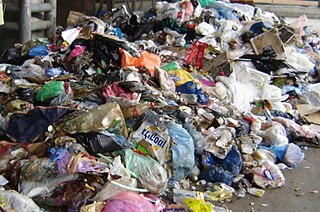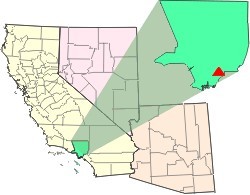Mallard Lake Landfill is a solid waste landfill in DuPage County, Illinois, west of Mallard Lake.
In 1974, the DuPage County Forest Preserve District established a solid waste landfill west of the lake. [1] The landfill began operation March 4, 1975 and the last load of waste arrived March 13, 1999. The landfill occupies 230 acres (0.9 km2) and rises to 982 feet (299.3 m) MSL making it the highest point in DuPage County. [2] In 1994, the district contracted with Browning-Ferris Industries (BFI) for landfill gas extraction rights and electricity production with operations beginning November 1997. The district received royalties from the landfill gas of $71,276 in 2006 and $145,973 in 2005. [3]
On April 20, 2006, Tyanna and Jeff Cannata of West Chicago, filed a class action lawsuit [4] against the Forest Preserve District of DuPage County, the owner of the Mallard Lake landfill, and Browning-Ferris Industries (BFI), operator of the landfill, claiming that the landfill was the source of a carcinogenic contaminant, vinyl chloride, found in the well water in Carol Stream, Hanover Park, Bartlett, and Wayne Township. [5] The lawsuit was given class action status on behalf of 150 residents on October 11, 2006. [6]
In July 2006, the Illinois Environmental Protection Agency stated that many years of groundwater testing surrounding the landfill indicated no evidence of contamination and that during recent testing, no volatile organic compound contamination was found in about 103 down gradient private wells. [7] Joe Benedict, environmental services manager for DuPage County Forest Preserve District, reported that, based on the EPA results, there was no contamination. The DuPage County Health Department also tested 87 wells and found no vinyl chloride contamination. [8]
In October 2007, methane gas was found in probes installed around the boundaries of the Mallard Lake Landfill in DuPage County, Illinois. [9]

Hazardous waste is waste that must be handled properly to avoid damaging human health or the environment. Waste can be hazardous because it is toxic, reacts violently with other chemicals, or is corrosive, among other traits. As of 2022, humanity produces 300-500 million metric tons of hazardous waste annually. Some common examples are electronics, batteries, and paints. An important aspect of managing hazardous waste is safe disposal. Hazardous waste can be stored in hazardous waste landfills, burned, or recycled into something new. Managing hazardous waste is important to achieve worldwide sustainability. Hazardous waste is regulated on national scale by national governments as well as on an international scale by the United Nations (UN) and international treaties.

A landfill is a site for the disposal of waste materials. It is the oldest and most common form of waste disposal, although the systematic burial of waste with daily, intermediate and final covers only began in the 1940s. In the past, waste was simply left in piles or thrown into pits.

Toxic waste is any unwanted material in all forms that can cause harm. Mostly generated by industry, consumer products like televisions, computers, and phones contain toxic chemicals that can pollute the air and contaminate soil and water. Disposing of such waste is a major public health issue.

ASARCO is a mining, smelting, and refining company based in Tucson, Arizona, which mines and processes primarily copper. The company has been a subsidiary of Grupo México since 1999.
Tybouts Corner is an unincorporated populated place in New Castle County, Delaware, United States.

Municipal solid waste (MSW), commonly known as trash or garbage in the United States and rubbish in Britain, is a waste type consisting of everyday items that are discarded by the public. "Garbage" can also refer specifically to food waste, as in a garbage disposal; the two are sometimes collected separately. In the European Union, the semantic definition is 'mixed municipal waste,' given waste code 20 03 01 in the European Waste Catalog. Although the waste may originate from a number of sources that has nothing to do with a municipality, the traditional role of municipalities in collecting and managing these kinds of waste have produced the particular etymology 'municipal.'
The Forest Preserve District of DuPage County is a governmental agency headquartered in Wheaton, Illinois, United States. Its mission is to acquire and hold lands containing forests, prairies, wetlands, and associated plant communities or lands capable of being restored to such natural conditions for the purpose of protecting and preserving the flora, fauna and scenic beauty for the education, pleasure and recreation of the citizens of DuPage County.

Chemetco was formerly one of the largest United States refiners of copper from recycled or residual sources.

DuSable Park is a former commercial and industrial site in Chicago. It is located at the mouth of the Chicago River that has been the subject of environmental remediation and is awaiting redevelopment into a public park. The project, first announced in 1987 by Mayor Harold Washington, is named in honor Jean Baptiste Point du Sable, who settled nearby in the 1780s and is known as the "Founder of Chicago". The development at 400 Lake Shore began construction in 2024.

Dorney Road Landfill is a 27-acre (11 ha) municipal and industrial landfill in Upper Macungie Township and Longswamp Township, Pennsylvania that was polluted with toxic waste from 1952 to 1978. The site is surrounded by rural residences and farmland. The U.S. Environmental Protection Agency (EPA) added the site to the Superfund National Priorities List in 1984. The site was remediated and removed from the National Priorities List in 2018.

Municipal solid waste (MSW) – more commonly known as trash or garbage – consists of everyday items people use and then throw away, such as product packaging, grass clippings, furniture, clothing, bottles, food scraps and papers. In 2018, Americans generated about 265.3 million tonnes of waste. In the United States, landfills are regulated by the Environmental Protection Agency (EPA) and the states' environmental agencies. Municipal solid waste landfills (MSWLF) are required to be designed to protect the environment from contaminants that may be present in the solid waste stream.
Water contamination in Crestwood, Illinois, a village in Cook County, was discovered in April 2009, Tricia Krause and she reached out to a newspaper, which reported that the city had been using a well which was contaminated with toxic chemicals as the village's drinking water for 40 years.
The former Operating Industries Inc. Landfill is a Superfund site located in Monterey Park, California at 900 N Potrero Grande Drive. From 1948 to 1984, the landfill accepted 30 million tons of solid municipal waste and 300 million US gallons (1,100,000 m3) of liquid chemicals. Accumulating over time, the chemical waste polluted the air, leached into groundwater, and posed a fire hazard, spurring severely critical public health complaints. Recognizing OII Landfill's heavy pollution, EPA placed the financial responsibility of the dump's clean-up on the main waste-contributing companies, winning hundreds of millions of dollars in settlements for the protection of human health and the environment.

Rogers Road is a community located in Orange County, North Carolina. It is well known for its history of environmental injustice and battles thereagainst.
The Freeway Sanitary Landfill is a United States Environmental Protection Agency Superfund site that covers 140 acres (57 ha) in Burnsville, Minnesota. In 1971 the Minnesota Pollution Control Agency (MCPA) licensed the landfill to accept 1,920 acre-feet (2,370,000 m3) of household, commercial, demolition, and nonhazardous industrial wastes. The state permit prohibited the disposal of liquids and hazardous wastes; however, heavy metals, acids, and bases were accepted by the landfill from local industries. The landfill also accepted 200 cubic yards (150 m3) of battery casings and 448 short tons (406,000 kg) of aluminum sweat furnace slag. Overall, the landfill contains nearly 5,000,000 cubic yards (3,800,000 m3) of waste. The waste is covered by a low permeability soil cover.

The Waste Disposal Inc. Superfund site is an oil-related contaminated site in the highly industrialized city of Santa Fe Springs in Los Angeles County, California. It is approximately 38 acres (15 ha), with St Paul's high school immediately adjacent to the northeast corner of the site. Approximately 15,000 residents of Santa Fe Springs obtain drinking water from wells within three miles (4.8 km) of the site.

The Philip H. Sheridan Reserve Center is the former Fort Sheridan now in Lake Forest, Highwood, and Highland Park in Lake County, Illinois, United States. It was originally established as a United States Army Post named after Civil War Cavalry General Philip Sheridan, to honor his services to Chicago. When the main fort was officially closed by the Army on May 3, 1993, the majority of the property was sold by the Department of Defense to commercial land developers. Most of the original housing structures were then refurbished and resold as a residential community. Other buildings were given to cultural organizations like Midwest Young Artists, the largest youth music program in the Midwest. Approximately 90 acres (36 ha) of the southern end of the original post were retained by the Army; there the Army now operates the Sheridan Reserve Center complex.
Emmell's Septic Landfill (ESL) is a landfill in Galloway Township, New Jersey and takes up about 38 acres of space. The landfill was in operation from 1967 until 1979. ESL disposed of liquid and solid waste including many chemicals such as volatile organic compounds (VOCs), Polychlorinated Biphenyls (PCBs), Trichloroethene and Vinyl chloride which all had their own effect on the environment and community. These chemicals affected the groundwater required millions of dollars to reconstruct the groundwater pathways and provide clean water to residents. The landfill holds a Hazardous Ranking Score of a 50/100, qualifying for the Superfund National Priority List. In August 1999, the state acknowledged the site's contamination and held town meetings and provided research upon the site such as groundwater samples. In July 1997, a sitewide investigation was called upon by the United States Environmental Protection Agency. In total the clean up was estimated to cost $5 million to fund this superfund site, and a grant of $3.9 million was given by the Federal Government under the Recovery Act Funding (Previti). Today, the project is still ongoing however, greatly improved since the landfill was discovered.
The K & L Avenue Landfill, also known by the spelling K&L Avenue Landfill, is an 87-acre (35-hectare) Superfund site accessed from KL Avenue in Oshtemo Township, Kalamazoo County, Michigan. It is one of six Superfund sites in the Kalamazoo River watershed.
This timeline of events related to per- and polyfluoroalkyl substances (PFASs) includes events related to the discovery, development, manufacture, marketing, uses, concerns, litigation, regulation, and legislation, involving the human-made PFASs. The timeline focuses on some perfluorinated compounds, particularly perfluorooctanoic acid (PFOA) and perfluorooctanesulfonic acid (PFOS) and on the companies that manufactured and marketed them, mainly DuPont and 3M. An example of PFAS is the fluorinated polymer polytetrafluoroethylene (PTFE), which has been produced and marketed by DuPont under its trademark Teflon. GenX chemicals and perfluorobutanesulfonic acid (PFBS) are organofluorine chemicals used as a replacement for PFOA and PFOS.